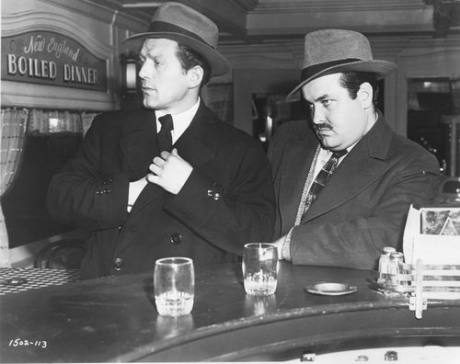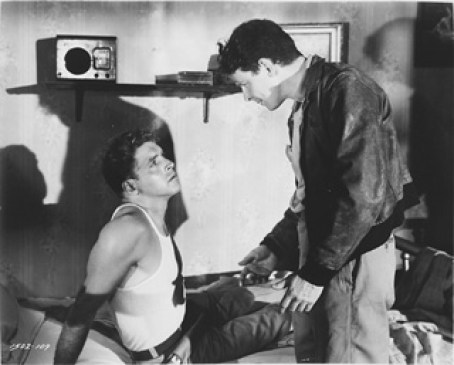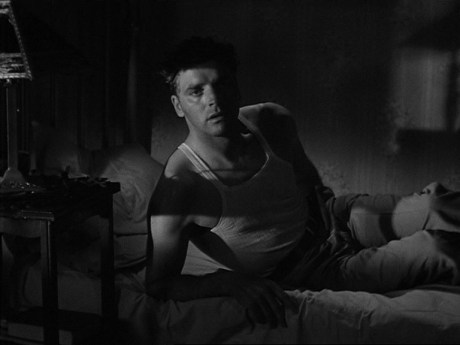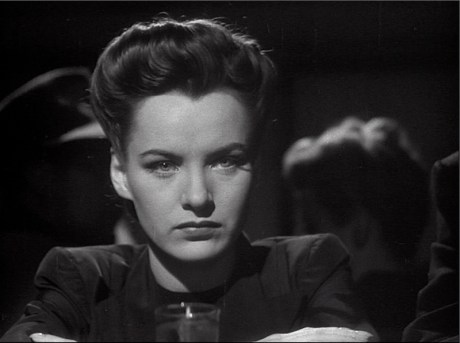
They Live By Night (1948) Directed by the great Nicholas Ray. Ray was responsible for one of my all-time favorite films with Bogie and Gloria Grahame, In A Lonely Place (1950), and he also gave us On Dangerous Ground (1952), Rebel Without A Cause, and Joan Crawford in Johnny Guitar.
They Live By Night is an adaptation by Nicholas Ray from the Novel “Thieves Like Us” by Edward Anderson. Produced by John Houseman.
Farley Granger plays Bowie, Cathy O’Donnell is the simple girl Keechie, Howard Da Silva is the ruthless”one-eyed “Chickamaw, Jay C.Flippen is T-Dub, and all three men make up the band of criminals responsible for robbing “charging “banks, across Texas. Will Wright plays old man Mobley a drunk (Ben Weaver, cantankerous store owner in The Andy Griffith Show) Helen Craig, plays Mattie who is married to T-Dub’s brother who is stuck in jail, having difficulty getting paroled.
“This boy and this girl were never properly introduced to the world we live in…
To tell their story…

Ray uses open vistas, the cars driving through open expanses of land, not the often dominating skyscrapers, or closely cropped staircases and framed structural shadows. yet a certain desolation permeates the screen. Textually and thematically, They Live By Night breaks away from the urban milieu and plants itself in the rural countryside, in contrast to other darker noir environs.

This is yet another RKO excursion into the noir realm that they became well known for. RKO had been one of the original production studios from the Golden Age of Hollywood. Val Lewton had done his low-budget yet groundbreaking horror collection(I Walked With A Zombie, Bedlam, Cat People, Isle Of The Dead) while at RKO.
There is a sentimentality and romanticism surrounding our two lead actors, the young couple project innocent victims, who were just born into a bad station in life. We get the sense that had they have been given another set of circumstances in another place, their lives would have been so far contrasting to the lives they’re leading because Bowie and Keechie are both essentially good people. We also see the very plain and feral Keechie blossom into her sexuality, as Bowie awakens this primal undercurrent that’s been subverted by her sheltered existence.


The certain outcome they faced, was always inevitable because they never had a chance to rise above the choices they’d been given.
There is so much of the narrative focused on what “other people normally do”, “to be like everybody else”. Our two young figures are trapped in a world, not of their own making.
Though most of the story is set in the rural countryside, which opens up the environment from the usual claustrophobic city scenes and defies the familiar mechanism of darkness, They Live By Night has an oppressive sensibility that makes the film a dark piece. The protagonist Bowie is still closed in by his situation.
Another departure from the more commonly seen protagonists with rough exteriors like Richard Conte, Robert Ryan and Charles McGraw, Farley Granger exudes a sexual ambiguity. Granger’s characters (Rope (1948), Strangers on A Train (1951), Side Street (1950)) have often been morally weak and susceptible to crime, not able to hold off temptation. He projects a sullenness, a softness that makes him appear the noir victim.


The divergence of the gentle souled Bowie with the cutthroat ruthlessness of his two treacherous partners in crime, set up the combustible dynamic that threatens Bowie’s safety from the outset.
As the lush and poignant music opens, it creates an unusual mood for us, not the typically hard-edged jazz thematic score we’re used to hearing with dark noir offerings. They Live By Night starts by serenading the sweet embraces of Farley Granger’s Bowie and O’Donell’s naive Keechie. The musical strings become threatening and the Titles roll as an old jalopy is driving eclipsed by the words They Live By Night.
It’s the 30s and two jalopies are speeding furiously down a desolate road. We see Bowie toss his shirt out of the car, and four men in the car, spin off the side of the road stirring up a dirt cloud, as they stop the car.


“I knew that tire had to go,” a farmer they’ve kidnapped says to Bowie sitting in the back seat. 2 men step outside of the car holding guns, one of them, Chickamaw wearing a hat says “You talk too much” The dusty isolation frames the men like a gray wilderness.
Chickamaw jerks the farmer out of the car as he begs, “Please mister please.” At first, Chickamaw holds a rifle up to his face as if threatening to shoot, instead he is forced to the ground out of our view, obscured by the car but we hear Chickamaw pounding on the farmer. The music is serious, the horns play brutal tones, and then we see a concerned expression come over Bowie watching from his viewpoint, startled at the brutality he is witnessing. We get a glimpse of humanity in one of the 3 thieves.
We can’t see but we hear “Smack, smack” like pops and bones breaking. The picture, the photograph we see is so filthy, the environment itself so angry, like the dirt could devour all the men whole.
They toss the beaten man into the back of the car and Chickamaw says “Now what” T Dub replies “Now we gotta get to that brother of yours and get to that doe you got stashed away.”
The 3 men leave on foot we get an aerial view of them walking in the tall grass passing a billboard sign that says “Cosmo Nifties.” Bowie falls and grabs his foot. “How far we gotta go?” “About 10, 15 miles.” Bowie’s foot appears injured. The two other men tell him to hide out in the bushes beneath the billboard and that they’ll be back for him at night. They tell him to “take it easy son,” he says “I’ll take it easy. I gotta lawyer in Tulsa to see.”
It is night now. The Cosmo Nifties sign bares a sultry-haired beauty with a flower in her hair, the sign shapeshifts on the screen into a fence. Bowie is peaking through the fence, and a little scrappy dog comes into the scene, Bowie sits back down the little approaches him for food. But he suddenly sees headlights of a car approaching. he looks through the fence again. The fence, he is fenced in. We hear the twinkling song of night crickets, a truck pulls up and stops, the breaks screeching to a halt.

Bowie steps out from behind the fence, and we hear the truck trying to be started but stalling. The dog is following him. He asks the driver, “you having trouble?” a voice shaded by the dark and a hat answer back. it is the soft comeback of a female voice, this is Keechie.
“Could be” he asks “Who are you? Do you live around here?” The crickets serenade the two veiled in shadow. Again the only two words she utters are “Could be.”
“You haven’t had a couple of visitors have you?” ” That wouldn’t be a sore foot making you limp would it?” “Could be” she says “I got some other stuff to pick up, get in or we’ll both get pneumonia” Her profile is solemn, and she looks down at the steering wheel.
She gets the car started and now her face is lit a little more, we can see she’s very plain, but very pretty, he comes around the side and starts to get into the car. A train whistle sings in the background. He looks at her “They sure took their sweet time sending for me”
Bowie asks “Who are you?” “they sent this for you, get in.” They arrive at a shabby place, in the car only the edges of their faces show light, like crescent moons, the rest is pure darkness surrounding them. They are staring at each other, she tells him “I’ll take that stuff, you go around the shed, through the trees, a cabin back there.”

He knocks on the door to the cabin, there are several men inside, one smoking a cigar opens it up to greet him with a smirk. Chickamaw says “Look who’s here” T-Dub sitting down counting money, says “Hello son,” Chickamaw says “You took your time gettin’ here… what are you and the gal been doin’, swimmin’?” “Say hello to Mobley, Chickamaw’s brother,” the old man says, ” I told you she’d find him… she’s a weasel that daughter of mine” “Sorry we had to keep you waiting son…had to be that way” Chickamaw gives Bowie a new shirt and says “here kid this’ll fit a lot better over that bandage.” He takes it, still very silent, Chickamaw slightly admonishing him says “You’re welcome.”

T-Dub, asks old man Mobley, “A thousand dollars, is that enough for a used car?” “Could be, you can’t tell though, the way things are…” They are interrupted by a sound outside, he says, “Oh that’d be my daughter.” T-Dub rises to his feet and says ” Hello Miss Keechie.” Bowie puts on his clean shirt and looks up at her, holding groceries, a surprised expression, as she too looks back at him curiously.
T-Dub looks at Chickamaw and gestures that he wants some of the cash, so he starts shuffling money through his thumb and fingers to hand to the old man, “That’s five hundred more, that’s fifteen hundred for the car… can’t have you coming back in no rattle trap, not for this trip.” Bowie with food in his mouth says “Fifteen hundred bucks for a second-hand car?” T-Dub says “That’s right” Bowie comes back. “That’s worse than robbing a bank!” but T-Dub explains “They’re thieves just like us” (meaning old man Mobley and his daughter Keechie).


T-Dub sits and faces the old man Chickamaw, “Now don’t forget the clothes, and tell Mattie the first big doe goes to getting her man out of jail.. tell her that or she won’t come.” “I’ll tell her for sure… well so long fellars… I’ll try to get back here with Mattie before tomorrow night.” Chickamaw says to his brother the old man Mobley, “Say big brother stay sober” he puts his hat on and answers “Me?…oh I won’t touch a drop, not a drop” he says resentfully. T-Dub still sitting down says, “Of course, he won’t, we take care of our friends Mobley” The old man cries out “I know, I know that T-Dub, he turns to Keechie and asks if she’ll take care of the station, then says “so long.”
Chickamaw says, “Take care of the station he says, he hasn’t done a lick of work in his life…that brother of mine.” Close up we now see that his right eye is hazed over and blind. He starts grinning and laughing, “Did you catch the look on his face?”…more laughter, “he’s still trying to figure out where I had that doe hid.” He laughs even more sardonically.

Keechie looks so worried. We hear a noise, Bowie is fiddling with the small stove, she goes towards him and says, “Can’t you make that stove work?” but as she starts to move, Chickamaw grabs her by the arm. “He’d a grab you too wouldn’t he?” T-Dub says, “You show ’em how Miss Keechie” “That’s one machine he don’t know nothing about..” Bowie hands her a clean cloth and says “Here”, she smiles a little and says “Thanks.”
T-Dub says, “That boy’s some gallant eh Miss Keechie?” and Chickamaw says “Yeah, he’s got a soft heart…” takes the cigar out of his mouth, “and a head to match”
Keechie says “his head looks alright to me” She gets up and walks away.
Bowie says “That little girl don’t think any too much of what’s me I tell you.”
Chickamaw relates “Her ma was just the same way, always acting like she was the Queen of Romania!” just then Keechie steps back from behind the heavy floral curtain that partitions the room. Bowie asks curiously “Keechie’s ma?” Chickamaw tells him “Yeah, you know what she did?…she ran off with a fella, now they’re running a medicine show” Keechie throws down what she was holding and walks back through the partition.

Fade to Black
T-Dub says “No matter how, I tell you we’re short…we need another thousand dollars” Chickamaw replies while looking at a newspaper “Hey we’re in it… Prison Farm break, the escape of 3 lifers was announced today by Warden E K Lardub (of some such name) the fugitives have captured a farmer in their flight”, then Chickamaw gets angry and slams down the paper. T-Dub picks it up and continues to read, “Elmo One Eyed Mobley” aka (Chickamaw) mumbles and paces, “It’s always one-eyed something.”
T-Dub reading “RT Waters, farmer of Akota, gave a description of the 3 men who commandeered his car at the point of a gun.” Chickamaw pipes in still pacing with the cigar in his mouth, “I shoulda blast his head off with that gun.”
T-Dub sees that there’s a dance at a dance hall that used to be Chickamaw’s old stomping ground, he gets the idea that there would be enough for the take there to be a small cushion for the big Zelton job they’re planning on.
Chickamaw picks up the paper from the table and says, “Sunday night, yeah that…” Then he pauses, “That one eye!…they didn’t’ print a very big piece about us either.” T-Dub says “Don’t wish it was more than just 2 lines..newspapers raise more heat than anything Chickamaw In a few days, they’ll really have somethin’ to print about us?” Bowie says “Yeah” and Chickamaw continues, “3 boys like us, we could charge any bank in the country, any bank!, how many have you knocked off T-Dub?” “Enough,” Chickamaw says to Bowie “You’re in luck kid, you’re traveling with real people“ T-Dub puts his hand on Bowie’s shoulder, and Chickamaw says “It takes 3 to charge a bank…and we’re the 3 mosquitas.”
“We move fast” looking deep into Bowie’s face. “Can you take it? “me?” “You!” “Sure.”
Bowie “I can rib myself up to anything,” Chickamaw says “Maybe. You ribbed yourself up once to killin’ a man didn’t ya?” Keechie walks into the room just then and looks faintly startled, and disappointed, Bowie stares at her concerned, and ashamed, Chickamaw asks again “Didn’t ya?” then Bowie breaks his gaze away from Keechie and looks up at Chickamaw and says “Yeah… I sure did” then looks back at Keechie who now looks down at the floor and walks out of the room.

It’s the first 10 minutes of They Live By Night that sets the stage for our ill-fated lovers.
To be continued in Part II…
They Live By Night (1948) Part Two “A woman is sort of like a dog”



















































































































































































































































































